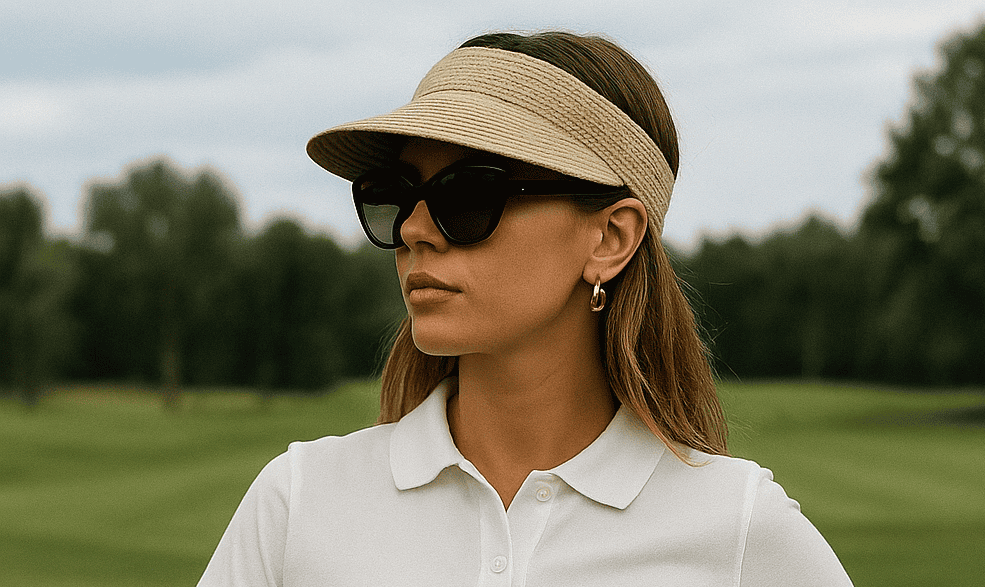The silence of the course, the morning breeze, and the sound of club meeting ball feel like a lesson in concentration. But even perfect technique won’t help if a hood slips over your eyes or your shirt overheats your shoulders. Golf clothing is part of strategy—just as vital as the choice of club. It regulates body temperature, adapts to swing range, and expresses the player’s personal taste.
The golf club has long evolved into a social stage. It’s not just about the scorecard anymore, but the details of appearance: the polo fabric, the cuff height, the shade of the visor. Modern golfwear must follow an invisible dress code while performing as athletic equipment. Achieving that balance requires an understanding of technology, trends, and one’s own movement.
Material and climate: fabric as technology
The first question a functional stylist asks is: “What is it made of?” Pure cotton feels good but holds moisture. Straight synthetic knits stretch well but overheat in the sun. The best brands use hybrid fibers: cotton-polyester blends, bamboo with nylon, micromodal with elastane. These fabrics wick sweat, prevent clinging, and stretch in four directions.
When temperatures rise above 25°C, UV protection ratings become essential. A tag marked UPF 40+ means the fabric blocks 97% of ultraviolet rays. In cooler seasons, weave density and moisture-wicking performance come first, so sweaters don’t gain weight after drizzle.
An unsung hero of the wardrobe is antibacterial coating. Silver ions or plant-based polyphenols prevent odor-causing bacteria from growing. This matters most during long rounds, where hours pass between swings. The player stays fresh without extra deodorant, and colors last longer.
Sustainability is also key. More clients are checking if brands use recycled fibers and reduce CO₂ emissions in dyeing. There’s a kind of quiet pride in a shirt whose diagonal stitching says both “style” and “conscious choice.”
Silhouette and freedom: design for movement
Every swing has amplitude, and clothing must respect it. The golden rule is anatomical tailoring. The shoulder area of a shirt is slightly widened, with seams moved to the back so they don’t rub during a smooth ladies’ swing or a full drive. Pants or skirt waistbands often include inner silicone strips—keeping polos tucked in through a dozen bends for tees.
Chest freedom comes from gussets sewn into the side seams. They’re invisible but create room for full torso rotation. Unlike a basketball jersey, which sags, a golf polo stays structured, doesn’t flutter in the wind, and doesn’t wrap around the club.
One key detail: sleeve length. Ideally, the cuff ends mid-bicep. This leaves smartwatches uncovered and shields the shoulder from sunburn. The sleeve fits snugly but never tight—allowing circulation. In winter versions, raglan sleeves reduce seams under jackets, minimizing friction.
Lastly, pant width matters. Slim chinos look sleek but can hinder deep squats for putting. Baggy pants rustle on the grass. A tapered cut with a mid-rise offers the sweet spot: clean silhouette and freedom to move.
Layering and adaptability: the 3/2/1 system
Weather shifts faster than a round’s rhythm, so wardrobes follow the “3/2/1” layer system. Each category plays a specific role:
- 3 – base — polos or tops touching the skin, wicking sweat, offering UV protection
- 2 – mid-layer — lightweight merino sweaters or softshells that trap heat and let moisture out
- 1 – shield — windbreakers or jackets for rain and autumn gusts
Mastering the 3/2/1 approach saves space in your bag and time in the locker room. One sweater and one waterproof shell cover temperatures from 10°C to 28°C. For every 10°C, subtract one layer.
A frequently missed point is color coordination. If the base is bold, outer layers should match or tone it down. A “layer cake” look is a rookie giveaway. Professionals build palettes so any combo feels seamless.
Color, pattern, and club dress code
Every club has unwritten rules. Some welcome pastels, others stick to navy and white. One rule stands: colors should complement the landscape, not clash with it. Neon lime grabs attention but distracts and unsettles playing partners. Dark khaki may blend into trees, which is unsafe — a golfer must stay visible.
A universal combo: a white or blush polo, graphite-blue trousers, and an ivory cap. This trio suits all lighting, doesn’t glare in photos, and flatters tanned skin without costume-like effects. For patterns, opt for micro-prints: subtle collar scripts or a faint check.
Golf dresses for women often include hidden shorts now—solving etiquette and comfort at once. Patterns follow suit: minimalist dots, slim stripes, or diagonal checkers. The key is not to turn the course into a runway. Fashion should elevate play—not replace it.
Smart details: from sole to visor
Golf shoes are their own science. The sole is divided into two zones: soft spikes in front for grip, cushioning in the heel. Removable spikes allow for adjustment to dry or wet greens and extend the shoe’s life.
Accessories keep evolving. Ultra-thin microfiber gloves manage sweat and work with touchscreens. Caps now feature gel-lined anatomical bands that cool under sun. A 3D layer above the visor channels vapor and keeps the forehead dry.
- gloves with built-in magnets to hold ball markers
- belts with hidden elastic zones adding two centimeters for easier bending
Small innovations solve big problems: reducing fatigue, improving swing accuracy, and preventing burnout. The gear lasts longer, the player feels better, and style doesn’t get compromised.
Personal signature: style as a reflection of character
On the course, more than just the swing is visible. Personal style shows in how a golfer fits the landscape, how their palette flows, and how clothes relate to the body. Sometimes a single touch makes a statement: signature socks, contrast stitching on gloves, or an iconic logo on a button.
The goal isn’t complexity—it’s memorability. It shows confidence when every piece is intentional and effortless. No sense of “wearing a costume.” The body moves freely, and the mind stays in the game.
Minimalist style wins again by being easy to care for. Fewer pieces, fewer wrinkles, faster prep. The “less but better” idea works on the green just like in the boardroom.
To complement your visual style with scent, many club members turn to signature fragrances. Learn how to find yours in the article “From bottle to identity: how club members choose their signature scent“.
Questions and answers
The shoulder seam should sit at the shoulder’s edge, the hem cover a third of the hip, and the collar should not squeeze the neck.
Yes—if it has a neutral design and removable features like hood spikes or collar trim that might clash with urban style.
Wash in cold water, use a gentle cycle without spinning, and lay flat to dry—this keeps fibers elastic and long-lasting.

